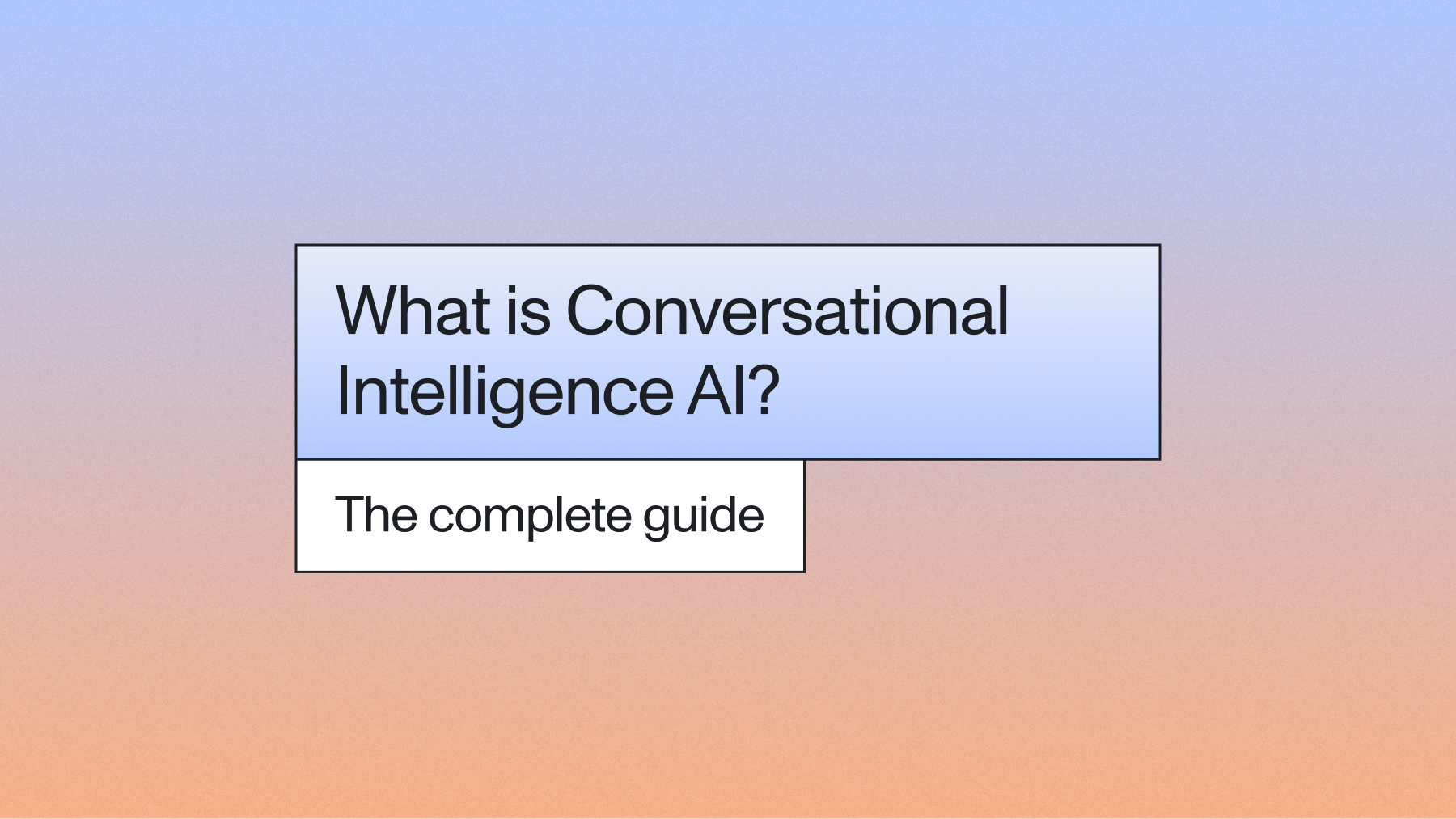Transformative use cases of AI in contact centers
What are the most important AI use cases for contact centers? What are some of the challenges for AI integration? What are the benefits? Read to learn more.





The rise of artificial intelligence (AI) in contact centers is no longer a future trend—it’s here, now, reshaping customer experience (CX) and redefining operational efficiency. From real-time agent guidance to voice agents capable of holding human-like conversations, AI technologies are powering a new era of conversation intelligence in modern contact centers.
This article explores the most impactful AI use cases in contact centers, from voice tech to predictive analytics, and shows how they’re delivering measurable business value today.
The role of AI in contact centers
Contact centers have evolved dramatically—from legacy IVR systems ("press 1 for billing") to intelligent, cloud-based platforms built using natural language understanding research. Today’s AI voice agents can hold nuanced, human-like dialogues with the aid of robust real-time transcription and large language models (LLMs). Some even orchestrate entire customer journeys across channels, or at least that will be one of the ongoing goals as product teams work to build intelligent cloud-based contact center solutions of the future.
The ROI is already there—conversation-based AI deployments will reduce agent labor costs by $80 billion by 2026, with 1 in 10 customer interactions becoming automated, according to Gartner.
According to Masterofcode, contact centers that have implemented AI are already seeing incredible results such as a:
- 69% improvement in customer service
- 55% reduction in wait times
- 54% increase in workflow efficiency
Test our speech recognition, speaker diarization, and sentiment analysis capabilities with your own call recordings in our interactive playground.
AI-assisted contact center platforms are being powered by several key technologies, working together to aid customers and augment the work of human agents:
- Speech AI: AI models that enable speech-to-text transcription, speaker diarization, sentiment analysis, intent detection, and more.
- Conversational AI: Virtual agents, chatbots, and voice assistants that handle customer inquiries. This includes both the more traditional text-based chatbot and AI voice agents, a new AI application that combines speech-to-text, LLMs, and text-to-speech for more organic-like AI/human interaction. Voice is quickly becoming the way we interact most commonly with AI and 2025 and beyond will see huge growth in this area.
- Predictive Analytics: Forecasting models for staffing, call volume, and customer behavior.
- Process Automation: Workflow automation for post-call work and case routing.
- Knowledge AI: Intelligent retrieval systems that provide agents with relevant information in real-time.
6 AI use cases in contact centers
Contact centers are integrating AI to power a multitude of use cases: from extracting insights from customer conversations to powering real-time agent assistance to replacing agents themselves.
Here are the six most impactful AI applications in modern contact centers:
- Real-time Agent Assistance
AI is being used to provide human agents with instant guidance during customer interactions. These tools can analyze conversations in real-time, using a streaming speech-to-text model to transcribe the conversation, retrieve relevant information, and can even suggest possible responses thanks to LLM integration. Contact center platforms that integrate AI-powered real-time agent assistance see, on average, a 27% reduction in call handle time. AI-assisted agents are able to handle 7.7% more simultaneous conversations (source). Other benefits include improved first-call resolution and decreased training requirements for new agents.
- Intelligent Routing and Customer Journey Orchestration
Contact centers are also building AI-powered tools that analyze customer data, history, and intent to automatically route interactions to the best-suited agent or self-service option. This intelligent workflow creates personalized journeys rather than generic queues and reduces hold times by more efficiently directing customers where they actually need to go.
Intelligent routing has been linked to a 10% improvement in customer satisfaction ratings, as well as increased operational efficiency.
- Automated Quality Monitoring and Compliance
Traditional sampling only allows managers to review ~1 to 3% of calls—with AI, that number shoots up to 100%. And not only can AI review each and every call that takes place, it can be used to sift through all of this historic call data to identify trends, surfacing these to inform best practices, identify potential compliance risks, or create coaching opportunities.
This minute call monitoring helps reduce quality inconsistencies among agents (and identify if/when an agent deviates from a script), as well as quickly flag potential PII (personal identification information) exposure to rectify and ensure compliance.
- Customer Intent and Sentiment Analysis
AI models like sentiment analysis and topic detection can also be used to build tools that detect customer sentiment, identify escalation risks, and predict customer needs. This in-depth analysis can then be used to predict potential for churn, measure customer satisfaction, or as an informal way of conducting product feedback.
Overall, AI-powered customer intent and analysis tools allow managers to be more proactive rather than reactive, improving overall customer service.
- AI-powered Self-service: Voice Agents and Conversational Interfaces
While AI chatbots have been around for some time, contact centers are now beginning to integrate voice AI agents that mimic human-customer interactions. In fact, the global voice AI agent market is projected to grow from $2.4 billion today to $47.5 billion in the next 10 years.
Voice AI agents are poised to serve two main use cases: replacing current inbound and outbound call volume (think after-hours service scheduling or appointment reminders) and net new applications. The ability of these AI agents to be available 24/7 to aid customers is a key benefit, though additional benefits and applications will become apparent as adoption and integration increases.
- Predictive Analytics and Business Intelligence
Contact centers are also using AI to build tools that transform contact center data into strategic business insights. AI can be used to identify insights into hold and call times, buying personalities, and more, which can then be used for more intelligent workforce forecasting, trend identification, and product improvement.
Examples of AI applications and solutions used in contact centers
Today’s contact centers are already integrating AI to build robust conversation intelligence tools.
1. Aloware
Aloware is an all-in-one contact center solution for sales engagement and automation. Its product team integrated AI, including AI call transcription, to power its complex workflows, including power dialing, automated multi-channel campaigns, call recording, and CRM integration. For its customers, these AI tools helped increase sales agent productivity, improve lead engagement, and enhance CRM management.
2. CallMiner
CallMiner is a CX conversation intelligence platform that helps companies gain comprehensive insights from customer interactions for quality and compliance. As a workflow, CallMiner most likely uses AI speech-to-text to transcribe calls then employs AI-powered analytic tools to identify agent adherence to scripts, flag compliance violations, and identify areas for agent performance improvement.
According to CallMiner, its conversation intelligence customers realize enhanced agent performance, improved regulatory compliance, reduced risk, and better customer experience through data-driven insights.
3. Glia
Glia is a finance-specific contact center solution for banking, credit unions, insurance, lending, and FinTech. As a workflow, Glia most likely uses AI speech transcription to turn agent-customer interactions into a knowledge-base that, with the aid of additional AI models and LLMs, can provide in-depth analysis of each call and aggregate call data when needed.
According to Glia, top benefits for its customers include improved agent efficiency, faster resolution times, enhanced first-contact resolution, and a more seamless digital customer experience.
4. NICE CXone
NICE offers comprehensive AI-powered features across the entire customer experience lifecycle via CXone. As a workflow, it most likely uses AI to power tools such as real-time agent guidance, automated quality management, and sentiment analysis across myriad communication channels.
For its customers, NICE cites its main benefits as improved agent productivity, enhanced customer satisfaction, streamlined operations, and better data-driven decision-making across the contact center.
5. Aquant.ai
In addition to conversation intelligence tools, Aquant.ai provides AI-powered voice agents for field service and technical support automation. For its workflows, the company most likely combines AI speech-to-text with domain-specific LLMs and knowledge bases to create voice agents that can diagnose equipment issues, provide technical guidance, and support field technicians. This workflow most likely leverages streaming, or real-time, speech-to-text for real-time transcription, contextual knowledge for troubleshooting, and conversational AI to maintain natural dialogue flow.
Companies that have integrated Aquant.ai’s AI-powered voice agents have noted the following benefits: reduced time-to-resolution for technical issues, 24/7 support availability for field technicians, decreased escalation rates to human experts, and improved first-time fix rates through consistent expert-level guidance.
6. Qualtrics
Qualtrics is an experience management software that helps companies manage and improve customer experience through data-driven insights and actions.
The company offers a suite of AI-powered tools, or “Qualtrics AI” that most likely work together to transcribe voice interactions within contact centers, analyze voice data along other feedback data (surveys, text messages, etc.), and identify key themes, sentiment, and drivers of customer satisfaction or dissatisfaction.
Post implementation, Qualtric users cite a better ability to identify and address key pain points, improved customer retention, and increased customer lifetime value.
Process thousands of hours of calls with our industry-leading accuracy and speaker diarization.
What are the benefits of using AI in contact centers?
Leveraging real-time transcription for contact center insights provides a host of benefits, including:
- Enhanced efficiency and automation
- More easily surfaced customer insights
- Increased customer satisfaction
- Smarter call routing
- More efficient and optimal quality management
- Cost reduction and resource optimization
- Data-driven insights, forecasting, and decision-making
And more.
Common challenges and drawbacks
As with any new technology, AI still presents some challenges and drawbacks.
Common challenges include:
- Data privacy, particularly in industries that handle sensitive customer data, such as medical information or PII
- Lack of human empathy and personalization in the design of current conversational AI chatbots and rudimentary AI voice agents
- Algorithmic bias and fairness of certain AI models
- Technical challenges and integration issues for companies starting to build with AI for the first time
- Customer acceptance and expectations if AI agents and AI analysis do not perform as expected
- Voice accuracy in noisy environments or among accented speech, depending on which speech-to-text model is integrated
- Integration complexity of multiple AI components (speech-to-text, LLMs, text-to-speech, etc.)
Final words
AI is not just improving contact centers—it’s transforming them. From cost savings and faster resolution to better customer experiences, the shift is undeniable. With the right implementation, AI like AssemblyAI’s Speech AI models help contact centers scale conversations, boost performance, and future-proof their operations.
Get started with AssemblyAI today and create industry-leading contact center tools.
Lorem ipsum dolor sit amet, consectetur adipiscing elit, sed do eiusmod tempor incididunt ut labore et dolore magna aliqua. Ut enim ad minim veniam, quis nostrud exercitation ullamco laboris nisi ut aliquip ex ea commodo consequat. Duis aute irure dolor in reprehenderit in voluptate velit esse cillum dolore eu fugiat nulla pariatur.
Related posts









